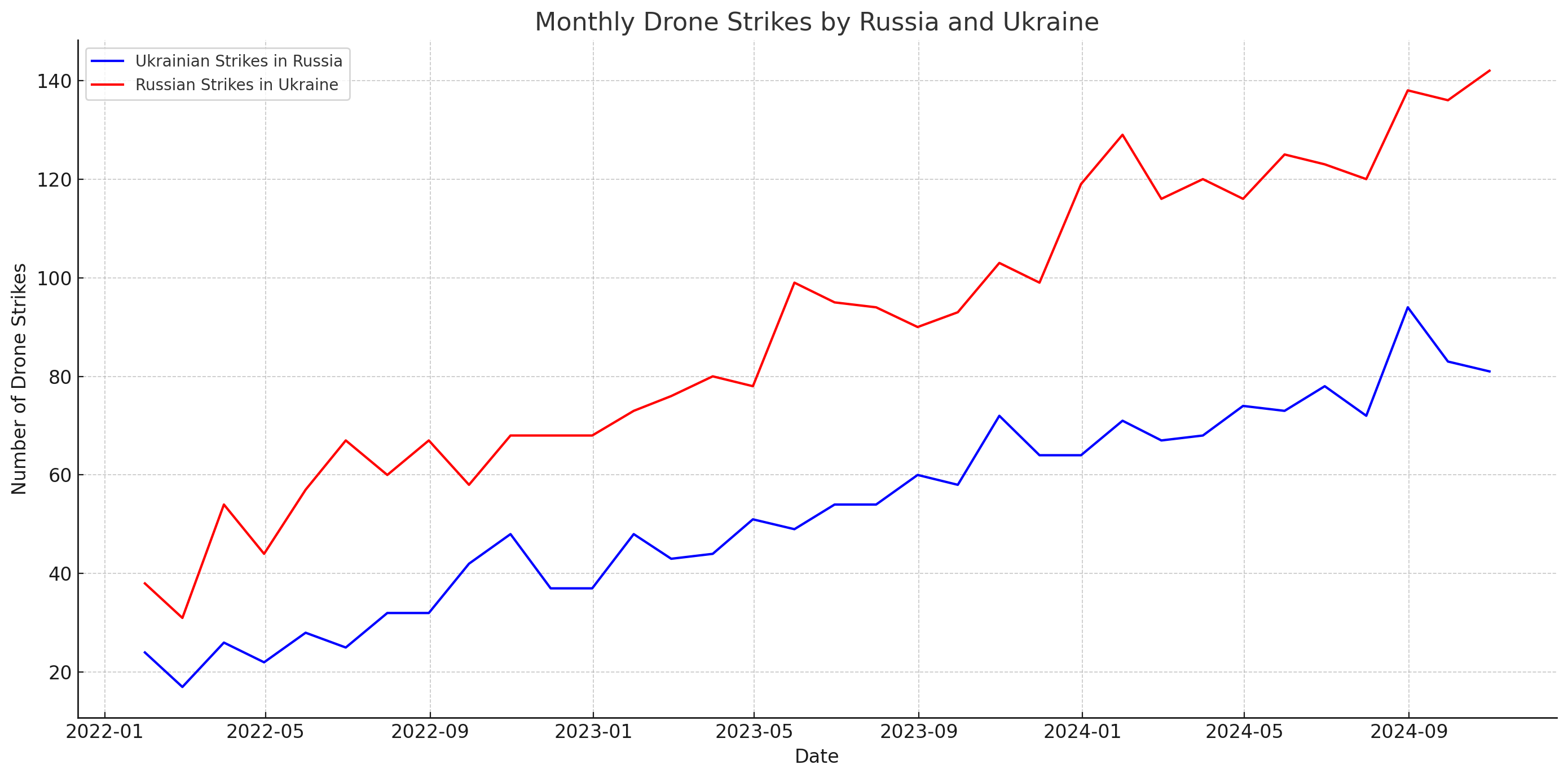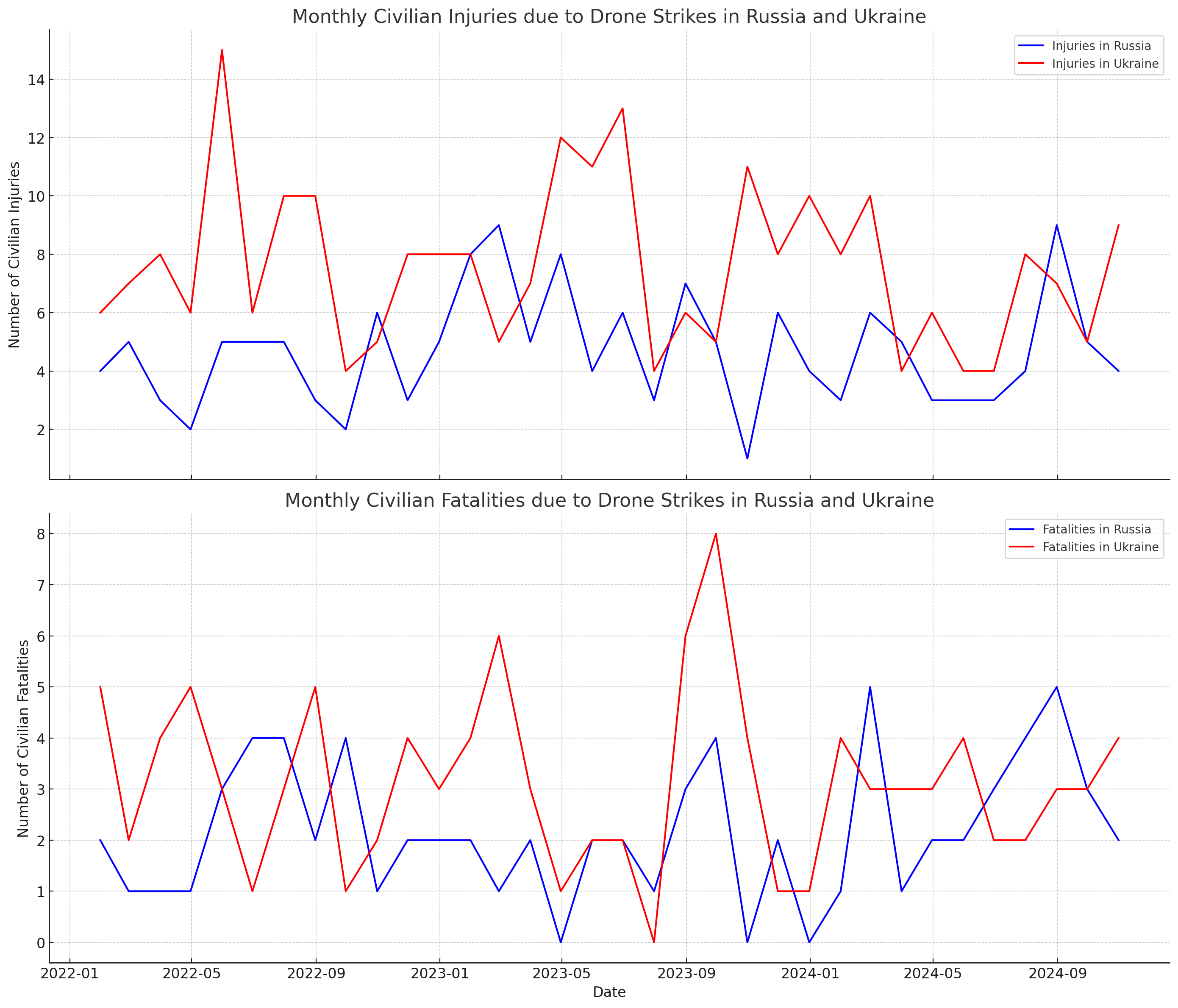As the war between Russia and Ukraine approaches the end of its second year, recent developments mark a significant escalation in military actions between the two nations.
Over the weekend, Ukraine launched its largest drone attack on Moscow since the beginning of the conflict, intensifying a pattern of aggressive tit-for-tat tactics that signal no end in sight.
The event left five people injured and caused disruptions at Moscow’s major airports as both countries used massive drone deployments against each other’s territories.
The latest chapter in this conflict may foreshadow potential tactics and diplomatic engagement shifts, especially with Donald Trump’s recent election and promises of accelerated peace.
The Biggest Drone Strike on Moscow Since 2022
On Sunday, Ukraine conducted a series of coordinated drone attacks on Moscow, the largest assault on the Russian capital since the conflict began in early 2022. At least 34 drones buzzed through Moscow’s airspace, with Ukrainian forces targeting key urban areas as well as critical infrastructure.
Russian authorities quickly responded, with the Ministry of Defense reporting the interception of numerous drones before they could reach their intended targets. Nonetheless, the incident temporarily paralyzed three of Moscow’s main airports—Domodedovo, Sheremetyevo, and Zhukovsky—forcing more than 36 flights to divert. Flight operations were eventually resumed, but the disruption highlights the escalating vulnerability of Russia’s core urban and transport systems.
This episode is emblematic of Ukraine’s evolving strategic approach. Rather than engaging Russia solely within its borders, Ukraine has now brought the fight into the heart of Russian territory, attempting to weaken Russian resolve and possibly erode domestic support for the war.
Russian authorities have labeled these strikes as acts of terrorism, but they have also fueled a narrative of resilience and defiance among the Russian populace, underscoring the conflict’s intensification.

Russia’s Record Drone Launch Against Ukraine
The Russian response was equally fierce. Following Ukraine’s attack on Moscow, Russia launched what Ukrainian officials have described as a record-breaking drone strike, targeting multiple regions within Ukraine. According to the Ukrainian Air Force, Russia deployed a staggering 145 drones, the highest number seen in a single attack during the conflict.
This barrage reached deep into Ukrainian territory, from the Odesa region in the southwest to Mykolaiv in the south, where airstrikes left several residential buildings in flames, ultimately killing five people. While Ukraine managed to shoot down 62 drones, the country’s defense systems continue to strain under the sustained assault.
In Odesa, two civilians were injured as drones struck critical infrastructure, igniting fires and damaging buildings.
Despite Ukraine’s successes in intercepting a portion of these drones, Russian attacks demonstrate Russia’s commitment to using overwhelming drone swarms to degrade Ukrainian infrastructure and morale. Unlike conventional missiles, drones provide a lower-cost method to maintain pressure on Ukraine, even as the war strains both countries’ military budgets and resources.



The Trump Effect
The prospect of renewed U.S. involvement has intensified following the election of Donald Trump as the 47th president of the United States. Known for his unpredictability, Trump’s previous term in office saw a unique, if controversial, approach to international relations, including with Russia.
During his campaign, Trump promised that he could bring an end to the Russia-Ukraine war within 24 hours of taking office, but he has yet to reveal concrete plans. This vague promise, however, has fueled speculation over what changes in U.S. policy might emerge under a second Trump administration and whether his diplomatic tactics will favor Russia, given his historical rhetoric and gestures.
Ukrainian President Volodymyr Zelenskyy’s recent congratulatory call to Trump underscores the high stakes for Ukraine as the U.S. presidential transition unfolds.
Elon Musk, a known Trump supporter and the owner of SpaceX, which operates the Starlink satellite network vital to Ukrainian communications, also joined the call.
Musk’s participation highlights the complex network of private and governmental entities involved in the conflict and raises questions about how shifts in U.S. administration might impact support for Ukraine’s defense efforts.
Any signal of reduced U.S. support for Ukraine could embolden Russian forces, shifting the conflict’s dynamics in potentially destabilizing ways.

A New Battleground
Both Ukraine and Russia have embraced drone warfare as a central component of their military strategies, setting this conflict apart from previous large-scale engagements. Drones have proven invaluable for reconnaissance, offensive strikes, and psychological warfare, allowing both sides to bypass some conventional limitations.
For Ukraine, drones provide an opportunity to extend their operational reach deep into Russian territory, making up for the relative scarcity of traditional military hardware.
Russia, meanwhile, has benefited from Iranian-made drones, allowing it to conduct sustained attacks on Ukrainian infrastructure, with relatively low-cost payloads deployed across large geographical areas.
Both countries have invested heavily in drone technology, signaling a future in which aerial swarms and unmanned vehicles may dominate warfare.
Public Sentiment and the Domestic Fronts
The increased frequency and intensity of drone attacks have not only strained the resources of both countries but have also impacted public morale. For Ukrainians, the conflict has become a daily reality, with the constant threat of missile and drone strikes.
Yet Ukrainian resolve appears unwavering, fueled by the perception that the country’s survival is at stake. Kyiv’s leadership has leveraged this sentiment, with Zelenskyy regularly rallying his nation and appealing to international audiences for continued support.
In Russia, however, domestic sentiment is more complex. Moscow’s population has been largely insulated from the war’s direct impact—until now. The latest strikes on Moscow’s urban center, alongside previous incidents such as the destruction of drones near the Kremlin, have brought the war closer to the Russian public.
Although government censorship and state-run media have attempted to control the narrative, such high-profile incidents could stoke underlying anxieties and doubts about the war’s progress and purpose among the Russian population.

A Turning Point or Further Entrenchment?
The escalation of drone attacks between Russia and Ukraine reflects a critical juncture in the ongoing conflict. Both sides appear determined to press on, with neither showing significant signs of diplomatic engagement or compromise.
The latest round of attacks could signal an enduring shift in military tactics, with drone warfare setting the tone for future conflicts in this and other regions.
The upcoming inauguration of Donald Trump, who has hinted at a dramatic shift in the U.S. approach to the war, injects another layer of uncertainty.
While Trump’s claims of a quick resolution may seem appealing to war-weary populations, his potential strategies and their impact remain unknown.
For now, both Russia and Ukraine appear resolved to continue their campaigns, fueled by the belief that they can achieve a strategic victory or gain a favorable position at the negotiating table.
What lies ahead is a conflict that could either see intensified hostilities or a gradual move toward a mediated solution, depending on internal political pressures and international involvement.
This latest exchange, marked by unprecedented drone strikes, reflects the resilience—and tragedy—of a war that has become deeply embedded in the identities and futures of both Russia and Ukraine.


